Wales
1876-1939
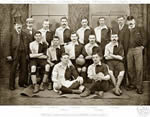 In January 1876 Llewellyn Kenrick responded to a challenge printed in The Field, to raise a Welsh football team to play a representative side from Ireland or Scotland in either the association or rugby code. Kenrick faced down his critics from South Wales who argued that Wales' representative team should play rugby football and in February 1876 at a meeting held in the Wynnstay Arms, Wrexham, he formed the FA of Wales (Cymdeithas Bêl-droed Cymru).
In January 1876 Llewellyn Kenrick responded to a challenge printed in The Field, to raise a Welsh football team to play a representative side from Ireland or Scotland in either the association or rugby code. Kenrick faced down his critics from South Wales who argued that Wales' representative team should play rugby football and in February 1876 at a meeting held in the Wynnstay Arms, Wrexham, he formed the FA of Wales (Cymdeithas Bêl-droed Cymru).
The Welsh team of the Edwardian era is associated with the brilliant Billy Meredith, a miner from Chirk who went on to play for both Manchester City and Manchester United, became involved in a bribery scandal, fell out with his managers on a regular basis and won 48 caps for his country. (He would have won more but his clubs refused to release him for 23 internationals.)
A clear distinction developed between South Wales, where rugby union was firmly established as the game of the working class and the more sparsely populated North Wales, where association football was more popular.
Wales joined the other British associations by leaving FIFA in 1928. In 1932, Wales played host to the Republic of Ireland, the first time they had played a team from outside the home nations. The following May they played France in Paris, the first time Wales had traveled outside the British Isles.
The first part of this section owes a great deal to Simon "Shakey" Shakeshaft who spent hours in the National Library of Wales in Aberystwyth ploughing through contemporary newspaper reports to compile the most complete record of early Wales' kits available.
Sources:
- National Football Museum of Wales
- Wales Match Shirts
- Simon Monks (1924)
- Wrexham Advertiser researched by Dylan Jones (1877-83)
- North Wales Chronicle April 1 1876 researched by Darren Foss - early crest
- Wrexham Advertiser researched by Mark Andrews (1894-95)
- Details of kits 1876-1905 from Simon "Shakey" Shakeshaft
- Leigh Roose (Welsh Football Data Archive)


 1876-1900
1876-1900
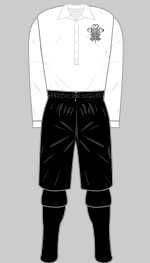
1876
Various socks worn
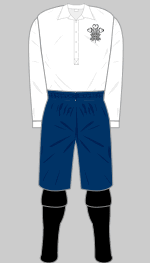
1877
Various socks worn
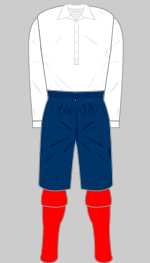
1879
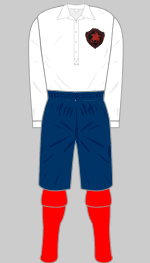
1880-1882
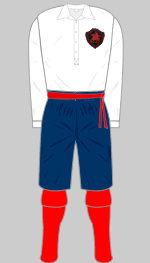
1880 v England
15 March
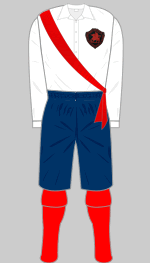
1881 v England
26 February
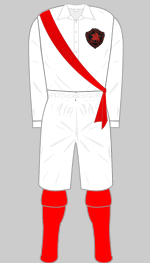
1882 v England
13 March
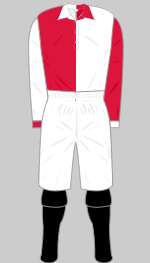
1883
Various socks worn
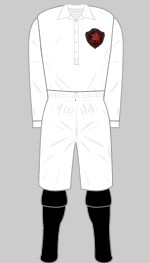
1884
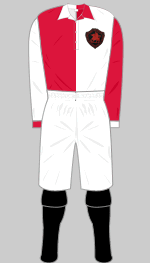
1885
Not all players wore crest
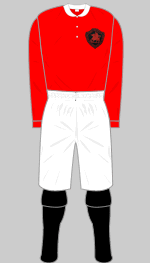
1886-1888
Not all players wore crest
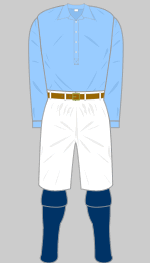
1889 v Scotland
15 April
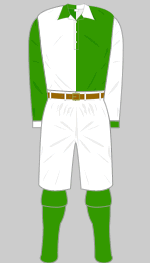
1889 v Ireland
27 April
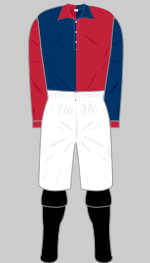
1889-1891
Some shirts reversed
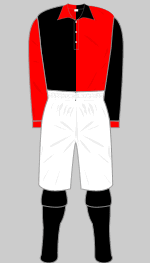
1892 v England
5 March
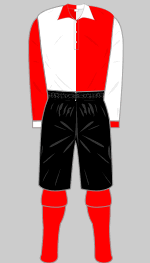
1893 v England
13 March
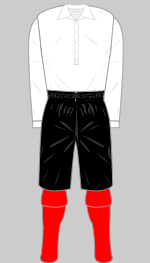
1893 v Ireland
5 April
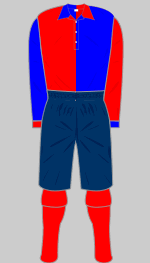
1894
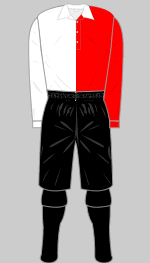
1895 v England
18 March
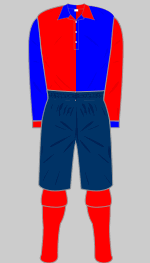
1895 v Scotland
23 March
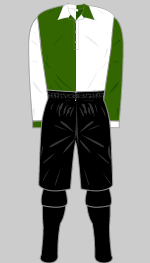
1896
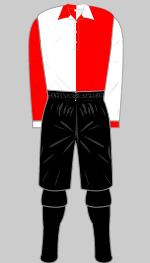
1897 v England
29 March

1898
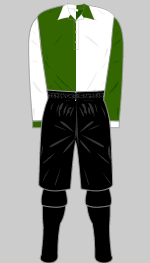
1899-1900
Designer:
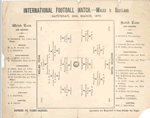 Wales' first game was played in Partick, Glasgow against Scotland, who won 4-0. A programme was printed for the match which, curiously, does not give details of the team's colours (which were white shirts/black knickers) but does describe the stockings worn by the players so spectators could distinguish one from another. The Welsh goalkeeper, for example wore "pale yellow and purple" socks while the Scotch (sic) left-back wore a brown pair.
Wales' first game was played in Partick, Glasgow against Scotland, who won 4-0. A programme was printed for the match which, curiously, does not give details of the team's colours (which were white shirts/black knickers) but does describe the stockings worn by the players so spectators could distinguish one from another. The Welsh goalkeeper, for example wore "pale yellow and purple" socks while the Scotch (sic) left-back wore a brown pair.
Dylan Jones has established that in the return fixture in 1877, Wales wore white shirts with the Welsh emblem (confirmed by Darren Foss as being the three feathers of the Prince of Wales) and (navy) blue knickers. Players provided their own socks until 1879 when the FA of Wales specified that these should be red.
Wales first played England at The Oval in January 1879, a match reduced to 60 minutes due to heavy snow. The home side played in their club jerseys so there was no clash with Wales' white shirts. In the return, however, England turned up in white. The match was delayed for 15 minutes while the Welsh returned to their dressing room where they fashioned some red material into belts. A similar solution was adopted for the next two England fixtures but a red sash was now draped across the Welsh shirts.
It was not until they played Ireland for the first time on 25 February 1882 that the Welsh recorded their first win, a crushing 7-1 victory followed by a 5-3 win against England.
In 1883 the British Home Championship was inaugurated and Wales now met the other home nations on a regular basis. Home games were normally played at Y Cae Raes (Racecourse Ground) in Wrexham although in February 1894, they entertained Ireland in Swansea, in the heartland of rugby union. Two years later Wales played England at Cardiff Arms Park and were thrashed 1-9.
The picture between 1883 and 1900 is confusing: while the team generally wore halved shirts, they appeared in a bewildering variety of colours. Not all of these changes can be explained by colour clashes and in some years different combinations were worn against different opponents. Because records are incomplete, this is noted below relevant graphics. In 1884 white shirts with a badge were worn although there is no record of what England wore when they met Wales.
A press report on the match against England in Wrexham described Wales' shirts as red and black. It may be that he was describing the cardinal/navy shirts worn earlier but this cannot be confirmed.
Two different crests were worn between 1876 and 1888, The first consisted of the Prince of Wales' feathers. This was replaced in 1880 by a red dragon passant, holding a football and surrounded by the legend "The Football Assocation of Wales Cymry (sic) Am Byth" on a black shield. At some point a new badge featuring a dragon rampant appeared on a maroon shield with the Welsh text now correctly spelled but so far we have not been able to establish any dates for this nor whether it was worn on team shirts. It is possible it was a blazer badge.
 1900-1914
1900-1914
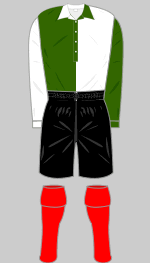
1900
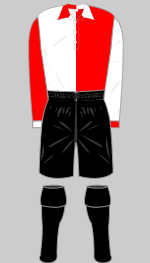
1901 v England
18 March
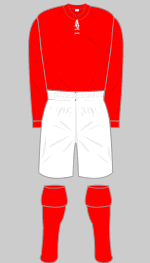
1902-1904
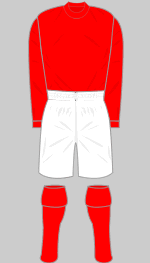
1905
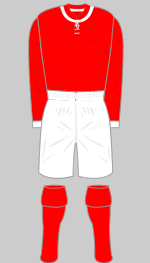
1906-1914
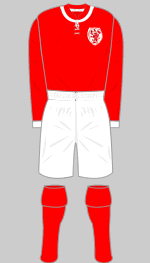
1906-1914 alternate
Designer:
In 1902 the FA of Wales (FAW) finally adopted red shirts and white knickers, the colours associated with the Welsh Rugby Union side, as their permanent colours, resolving at a stroke the problem of colour clashes with the other home nations that had been a feature of the previous century. The crest of the FAW was not always worn. After 1910 fixtures were shared between north Wales (usually Wrexham) and the south (usually Cardiff).
Although Wales joined FIFA in 1906, they continued to play fixtures exclusively with the other three British teams so no change kit was required. Players wore their club stockings. In 1907, with Meredith in great form, Wales won the Home Championship for the first time.

 1919-1940
1919-1940
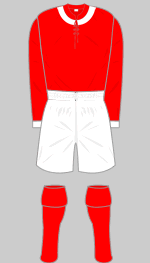
1919-1921
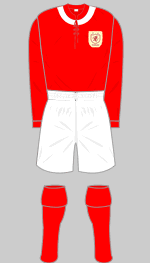
1921-1922
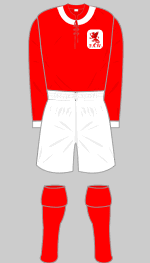
1924-1926
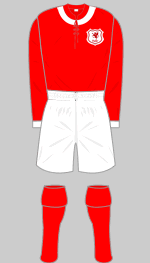
1926-1929
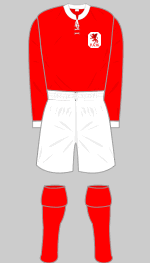
1929-1930
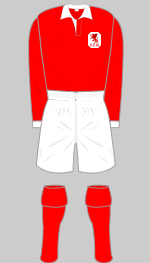
1931-1938
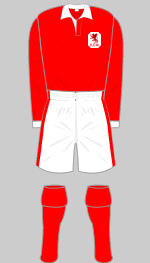
1939

1940
Designer: St Margrets
Welsh teams continued to play in red shirts with lace-up collars until 1930. More modern collars were introduced in 1931. A change kit was not required in this period and players continued to wear their club stockings until at least 1931 and possibly later. Home games were now played at the grounds of Cardiff City, Swansea Town and Wrexham. The iconic stripe down the side of the shorts made its first appearance in 1939 but was absent the following year.
Kits were manufactured by St Margrets who were a precurser to Marks & Spencers' St Michael's brand.
<Home Internationals Index Page :
Wales 1946-1963>
 In January 1876 Llewellyn Kenrick responded to a challenge printed in The Field, to raise a Welsh football team to play a representative side from Ireland or Scotland in either the association or rugby code. Kenrick faced down his critics from South Wales who argued that Wales' representative team should play rugby football and in February 1876 at a meeting held in the Wynnstay Arms, Wrexham, he formed the FA of Wales (Cymdeithas Bêl-droed Cymru).
In January 1876 Llewellyn Kenrick responded to a challenge printed in The Field, to raise a Welsh football team to play a representative side from Ireland or Scotland in either the association or rugby code. Kenrick faced down his critics from South Wales who argued that Wales' representative team should play rugby football and in February 1876 at a meeting held in the Wynnstay Arms, Wrexham, he formed the FA of Wales (Cymdeithas Bêl-droed Cymru).
























 1900-1914
1900-1914












